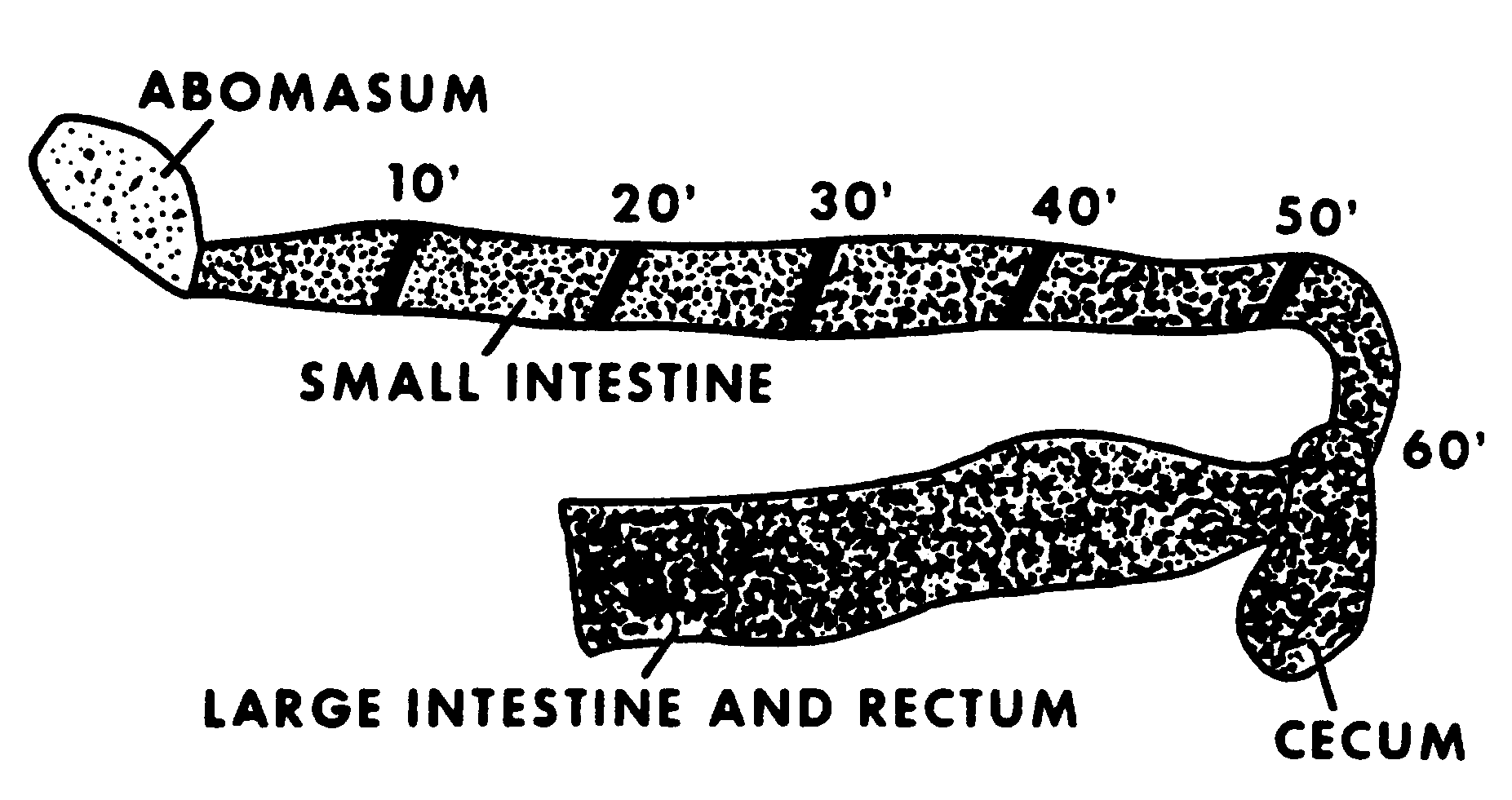
http://users.erols.com/drrobert.sids/summary.html
THE JOURNAL OF INFECTIOUS DISEASES • VOL. 128, SUPPLEMENT • JULY 1973
(c) 1973 by the University of Chicago. All rights reserved
.Summary of Discussion
Remarks of Dr. Robert C Reisinger
DR. REISINGER: I would like first to show you some things that you probably have learned but may have forgotten. This first slide (figure 1) is just to remind you that there are very few Escherichia coli in the more absorptive portion of the small intestine, the duodenum, jejunum, and proximal ileum. This is true of all mammalian species so far studied, including the cow and calf, the human infant and adult.

Figure 1. Distribution of Escherichia coli in the
intestinal tract of the normal calf.
The next slide (figure 2) shows what was demonstrated by Theobald Smith and Marion Orcutt in 1922, i.e.. that calves suffering diarrhea have tremendously increased numbers of E. coli in the intestinal tract. They described "a great increase in the number of E. coli in the lowest third of the small intestine with a spreading of the invasion towards the duodenum as the disease gains headway. Under these conditions, a general intoxication results . . . E. coli in the digestive tract has not been in general regarded as significant. This significance appears when the quantitative factor, obtained before natural death, is determined."

Figure 2. Distribution of Escherichia coli in the
intestinal tract of the scouring calf.
My work in Wisconsin, that of Gay in Canada, and that of Mebus in Nebraska confirmed that of Smith and Orcutt and further confirmed and demonstrated that the same mechanism of invasion of E. coli into the proximal small intestine may result in peracute deaths without septicemia and without diarrhea (SDS). Such deaths can occur within several hours after the feeding of an apparently healthy normal calf. Pathologic lesions at autopsy are absent or minimal. as in the crib-death syndrome in the human infant. Experimentally, the diarrhea syndrome can be precipitated by exposure to various viruses, cold and wet, avitaminous A, etc.—any "adverse contributing factor" that impairs optimal reticuloendothelial and/or gastrointestinal function. A classic feature of the calf-diarrhea syndrome is labored breathing (pneumonic signs without pneumonic lesions), but this disappears when, by appropriate antibiotic therapy, excessive numbers of E. coli are cleared from the digestive tract.
Bacterial endotoxins produced in the intestinal tract, which may be absorbed into the venous system, are transported directly into the liver. If for any reason these endotoxins are not inactivated in the liver, they obviously go via the inferior vena cave into the heart and lungs and, to a lesser extent (at least early in the syndrome), into the general arterial circulation.
Some factors common to many cases of SDS, the respiratory-distress syndrome, and endotoxin shock are hyperkalemia, hyponatremia, acidosis, thrombocytopenia, noncoagulability of blood, early respiratory signs without appropriate lesions, pulmonary edema, hemorrhage by diapesis, fast, weak pulse, and circulatory collapse. It is more illogical to consider these similarities as fortuitous than to realize the probability, or at least possibility, of a common cause or mechanism.
There are great differences between bacterial flora, pH, and physical characteristics of the intestinal contents of human infants fed human milk and these features in infants fed cow's milk. Due to its higher content of calcium and protein and its lower content of lactose, cow's milk fed to the human infant raises the E. coli count in the large intestine approximately 1,000-fold (from 106-107/g to 109-1010/g), raises the pH from acid (4.5-5.6) to alkaline (7.0-8.0), makes curds hard and coarse instead of soft and fine, and makes bowel movements relatively infrequent. Characteristics of a healthy human infant on human milk are a relatively low coliform count, acid pH, soft, fine curds, and frequent bowel movements. Even if there were no SDS, these adverse changes wrought by a diet of cow's milk any time during the first six months of age are against all reason in producing the optimally healthy child and the healthy adult he should become.
I believe that crib death, or SDS, is only the tip of the iceberg with regard to effects of absorption of bacterial endotoxin in the human infant. The vasoconstriction, vasodilation, disseminated intravascular coagulation, and other characteristic effects of endotoxin may well account for much of the pathology associated with many cases of cerebral palsy, mental retardation, learning and speech defects, retrolental fibroplasia, hyaline-membrane disease, etc. These latter diseases appear predominantly in infants with immature or otherwise impaired hepatic function, i.e., the immature infants of diabetic mothers, infants anoxic due to placenta praevia, infants whose birth is long and difficult, etc. In long and difficult births, there is also a prolonged in-utero opportunity for seeding of the infants' digestive tracts should infected amniotic fluid be swallowed.
Since absorption of endotoxin from the digestive tract is a confirmed fact in various mammalian species, the probability, or at least the possibility, of similar absorption from the intestinal tract of the human infant should be considered and investigated.